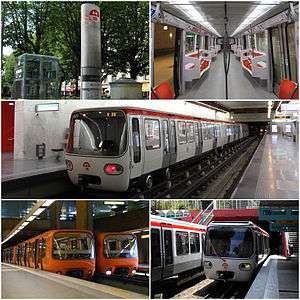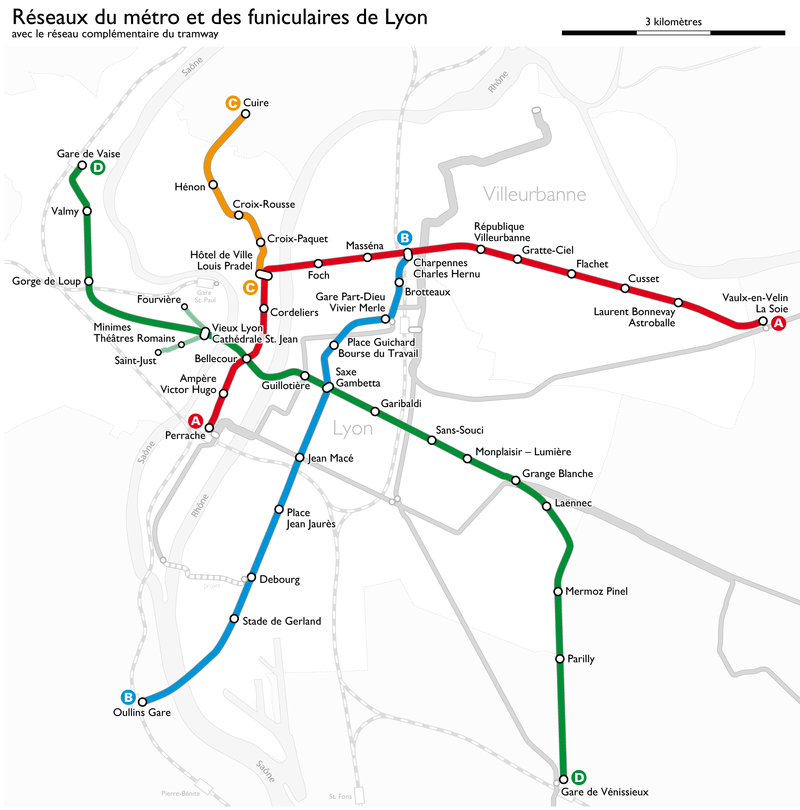Lyon Metro
 | |||
 | |||
| Overview | |||
|---|---|---|---|
| Native name | Métro de Lyon | ||
| Locale | Lyon, Rhône-Alpes, France | ||
| Transit type | Rapid transit | ||
| Number of lines | 4[1] | ||
| Number of stations | 40 | ||
| Daily ridership | 740,000 (weekday avg., 2013)[2] | ||
| Operation | |||
| Began operation | 1978 | ||
| Operator(s) | TCL | ||
| Number of vehicles | |||
| Technical | |||
| System length | 32.1 km (19.9 mi)[2] | ||
| Track gauge | 1,435 mm (4 ft 8 1⁄2 in) standard gauge with roll ways along the rails | ||
| |||
| Public transport in Lyon |
|---|
| Networks |
|
| Railway stations |
| Airports |
The Lyon Metro (French: Métro de Lyon) is the metro system of Lyon, France. It first opened in 1978[3] (although the metro's current Line C opened, independently, earlier, in 1974).[3] The Lyon Metro currently consists of four lines,[1] serving 40 stations (44 when counting transfer stations twice),[3] and comprising 32.0 kilometres (19.9 mi) of route.[2] It is part of the Transports en Commun Lyonnais (TCL) system of public transport, and is supported by Lyon's network of tramways.
Unlike all other French metro systems, but like the SNCF and RER, Lyon Metro trains run on the left. This is the result of an unrealised project to run the metro into the suburbs on existing railway lines. The loading gauge for lines A, B, and D is 2.90 m (9 ft 6.2 in),[4] more generous than the average for metros in Europe. The loading gauge for line C is 2.78 m (9 ft 1.4 in).[4] The Lyon Metro owes its inspiration to the Montreal Metro which was built a few years prior, and has similar (wider) rubber-wheel cars and station design. The metro had 740,000 daily weekday boardings in 2011.[2]
Routes
The Lyon Metro consists of four lines, A, B, C and D, each identified on maps by different colours:
| Line | Opened[3] | Length[2] | Stations[3] | Termini | Rolling stock |
|---|---|---|---|---|---|
| |
1978 | 9.3 km (5.8 mi) | 14 |
|
MPL 75 |
| |
1978 | 7.7 km (4.8 mi) | 10 |
|
MPL 75 |
| |
1974 | 2.5 km (1.6 mi) | 5 |
|
MCL 80 |
| |
1991 | 12.6 km (7.8 mi) | 15 |
|
MPL 85 |
Lines A and B
Line A (Perrache - Laurent Bonnevay) and Line B (Charpennes - Part-Dieu) were constructed by cut-and-cover and went into service on May 2, 1978, as the inaugural lines of the Lyon Metro. Trains on both lines run on rubber tyres rather than steel wheels.
Line B was extended to Jean Macé on September 9, 1981, to Gerland on September 4, 2000[3] and to Gare d'Oullins on 11 December 2013.[5]
An extension to Vaulx-en-Velin La Soie on Line A opened in October 2007.[3]
By 2020, Line A and B will be automated, with the same system as Line D.
Line C
The Croix-Rousse-Croix-Paquet rack railway, which was refurbished in 1974,[3] was integrated into the Metro in 1978 as Line C, with an extension to Hôtel-de-Ville[3] (thus running from Hôtel-de-Ville to Croix-Rousse). It was extended to Cuire on December 8, 1984.[3]
The line was constructed using various methods; the incline rising through a deep tunnel, the portion on the flat at Croix-Rousse using cut-and-cover while the section beyond Hénon runs on the surface. The Croix Paquet station claims to be the steepest metro station in Europe, with an incline of 17%.
Line C uses an overhead wire while Lines A, B and D use a third rail.
Line D
Line D, the first fully automatic metro line in France, started with operators on board trains on September 4, 1991, between Gorge-de-Loup and Grange-Blanche. The line was extended to Gare de Vénissieux on December 11, 1992,[3] when it switched to driverless operation. On April 28, 1997, it was extended again to Gare de Vaise.[3]
Using rubber tyres like on lines A and B, trains on line D are controlled by a system known as MAGGALY (Métro Automatique à Grand Gabarit de l’Agglomération Lyonnaise). Unusually for a driverless metro, no platform screen doors are installed on station platforms. The trains use infrared sensors to detect obstructions on the track. Only the Nuremberg U-Bahn does so as well.
The deepest of the lines in Lyon, it was constructed mainly using boring machines and passes under both rivers, the Rhône and the Saône. At 12.5 kilometres (7.8 mi) long with 15 stations,[3] it is also the longest line in Lyon.
Operation
The Metro, like the rest of the local public transport system, is operated by SLTC - the Société lyonnaise de transports en commun (Lyon public transport company), under the TCL brand - Transports en commun lyonnais (Lyon public transport). It is operated on behalf of SYTRAL - the Syndicat de transports de l'agglomération lyonnaise (Lyon metropolitan transport syndicate), a Syndicat Mixte.
See also
References
- 1 2 "TCL - Le réseau - Un réseau dense et complémentaire" [TCL - The network - A dense and complementary network] (in French). TCL. Retrieved 2013-09-28.
- 1 2 3 4 5 "Les lignes de Métro et de Funiculaire" [The lines of the metro and funiculars] (in French). SYTRAL. Retrieved 2015-01-23.
- 1 2 3 4 5 6 7 8 9 10 11 12 13 "Le Métro sur le réseau TCL" [The Metro/Subway of TCL's network] (in French). TCL - SYTRAL. Archived from the original on 2014-10-08. Retrieved 2013-09-28.
- 1 2 "Lyon". UrbanRail.Net. Retrieved 2015-01-23.
- ↑ "Le prolongement du métro B à Oullins" [Extension of the metro Line B to Oullins] (in French). TCL - SYTRAL. Retrieved 2013-10-01.
External links
![]() Media related to Lyon Metro at Wikimedia Commons
Media related to Lyon Metro at Wikimedia Commons
- Lyon Metro Map on Google Maps with Geolocation
- TCL – official website (French)
- Lyon at UrbanRail.net (English)
- Comprehensive map of the Lyon metro network (French)
- Métro de Lyon (French) – French Wikipedia has a much more detailed description of the Lyon Metro
